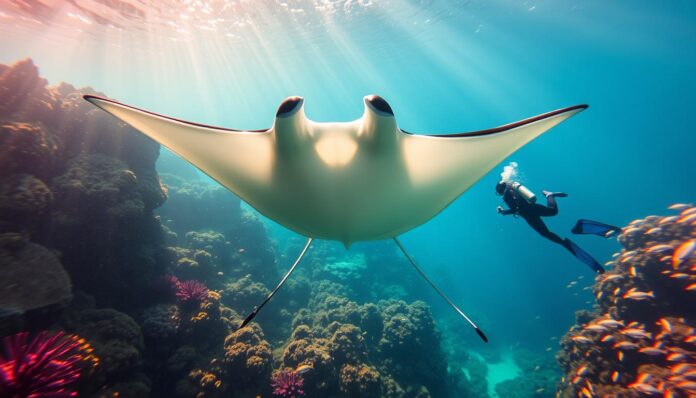Imagine seeing a creature as big as 22 feet wide and almost two tons heavy. Yet, it moves through the ocean with incredible grace. Diving with manta rays is an experience like no other, turning ordinary marine encounters into unforgettable ones.
Scuba diving with manta rays is the safest way to interact with large sea creatures. These amazing animals don’t bite or sting, making them perfect for those looking for a unique Manta Ray experience. You can find them in places like Socorro Island and Hawaii’s clear bays, inviting you to explore their underwater world.
Every year, divers from all over the world come to see these incredible animals. With over 500 oceanic manta rays in Socorro Island and 240 named reef manta rays in Kona, Hawaii, the chances for amazing underwater adventures are endless.
Key Takeaways – Scuba Diving with Manta Rays
- Manta rays are the largest rays in the ocean, reaching up to 22 feet wide
- Diving with manta rays is considered the safest large animal interaction
- Multiple global locations offer exceptional manta ray diving experiences
- Manta rays are non-aggressive and incredibly graceful marine creatures
- Peak manta ray seasons vary by location, but there’s always a chance to see them
Introduction to Manta Rays
Manta rays are among the most captivating sea creatures. They amaze people with their size and smarts. Their huge wings and complex ways make them special ocean dwellers.
Exploring manta rays shows us amazing facts about them. With over 600 ray species, manta rays are truly remarkable.
What Makes Manta Rays Unique?
Manta rays have traits that make them stand out:
- Exceptional brain size: Their brains are 10 times larger than whale sharks
- Massive wingspan: Can grow up to 30 feet from wing tip to wing tip
- Filter feeding capabilities: Consuming up to 11 pounds of zooplankton daily
- Longevity: Living between 40 to 50 years
Conservation Importance of Manta Rays
Manta rays need our help now. They are listed as vulnerable on the IUCN Red List. Human actions pose big threats to them.
| Threat | Impact |
|---|---|
| Fishing Bycatch | Primary risk to population survival |
| Traditional Medicine Trade | Decreasing population numbers |
| Heavy Metal Contamination | Potential long-term health risks |
Protecting manta rays is key to keeping our oceans healthy. Scientists and marine experts study them. They show how vital manta rays are for ocean life.
Best Locations for Manta Ray Diving
Exploring the world’s top Manta Ray hotspots can turn a simple dive into a thrilling marine adventure. People look for places that offer amazing manta watching tours. These tours provide unforgettable underwater experiences.
Asia:
- Maldives: The Maldives is renowned for its clear waters and abundant marine life. Several dive sites throughout the Maldives offer the chance to encounter manta rays, particularly in the Baa Atoll, where a designated UNESCO Biosphere Reserve protects these majestic creatures.
- Indonesia: With its vast archipelago, Indonesia offers numerous manta ray hotspots. Komodo National Park, Raja Ampat, and Nusa Penida are just a few of the popular destinations where divers can witness the mesmerizing beauty of manta rays.
- Mozambique: Along the eastern coast of Mozambique, the waters of Tofo and the Bazaruto Archipelago provide opportunities to dive with manta rays. These locations boast vibrant coral reefs and encounters with other marine species, creating a remarkable diving experience.
- Seychelles: The pristine waters surrounding the Seychelles islands are home to diverse marine life, including manta rays. The Aldabra Atoll, a UNESCO World Heritage Site, is a prime location for encounters with these gentle giants.
- Mexico: The Revillagigedo Islands, also known as the Socorro Islands, off the Pacific coast of Mexico, offer incredible encounters with manta rays. These volcanic islands attract a variety of marine species, including mantas, making it a sought-after destination for manta ray diving.
- Bonaire: The island of Bonaire in the Dutch Caribbean is renowned for its excellent diving conditions. Alongside beautiful coral reefs, divers may have the opportunity to spot manta rays gliding through the clear turquoise waters.
- Costa Rica: Cocos Island, located off the coast of Costa Rica, is a UNESCO World Heritage Site known for its extraordinary marine biodiversity. Diving in the nutrient-rich waters surrounding the island provides a chance to encounter manta rays, as well as other large pelagic species.
- Belize: Belize’s Barrier Reef, the second-largest coral reef system in the world, offers manta ray encounters in locations such as the Gladden Spit Marine Reserve. This reserve is famous for the annual “manta ray ballet” during the full moon, when mantas gather to mate and feed.
- Azores, Portugal: The Azores archipelago in the Atlantic Ocean is a haven for marine life, including manta rays. The waters surrounding these volcanic islands provide opportunities for encounters with these gentle giants, along with other pelagic species.
- Australia: Lady Elliot Island, located on the Great Barrier Reef, is a renowned hotspot for manta ray encounters. With its crystal-clear waters and abundant marine life, divers can witness the grace and beauty of manta rays in their natural habitat.
- Fiji: The waters of Fiji are home to several manta ray cleaning stations, where divers can observe the cleaning interactions between manta rays and cleaner fish. Beqa Lagoon and the Yasawa Islands are popular destinations for manta ray diving in Fiji.
- Hawaii, United States: The Hawaiian Islands offer excellent opportunities for diving with manta rays. Nighttime dives in Kona, on the Big Island, provide the unique experience of witnessing manta rays feeding on plankton, illuminated by dive lights.
- Socorro Islands, Mexico: The Socorro Islands, part of the Revillagigedo Archipelago, attract large numbers of manta rays. Diving in these remote and pristine waters offers unforgettable encounters with mantas, along with other pelagic species like sharks and dolphins.
- Galapagos Islands, Ecuador: The Galapagos Islands, a UNESCO World Heritage Site, are renowned for their remarkable biodiversity. While exploring the marine reserves around the islands, divers may have the opportunity to encounter manta rays, along with a multitude of other unique marine species.
- Malpelo Island, Colombia: Malpelo Island, located in the Pacific Ocean, is a remote and protected marine sanctuary. Diving around the island allows for encounters with large schools of fish, sharks, and manta rays, creating an exhilarating underwater experience.
These destinations offer some of the best opportunities to dive with manta rays in various regions around the world. Each location provides a unique experience, allowing divers to witness the grace and magnificence of these gentle giants in their natural environments.
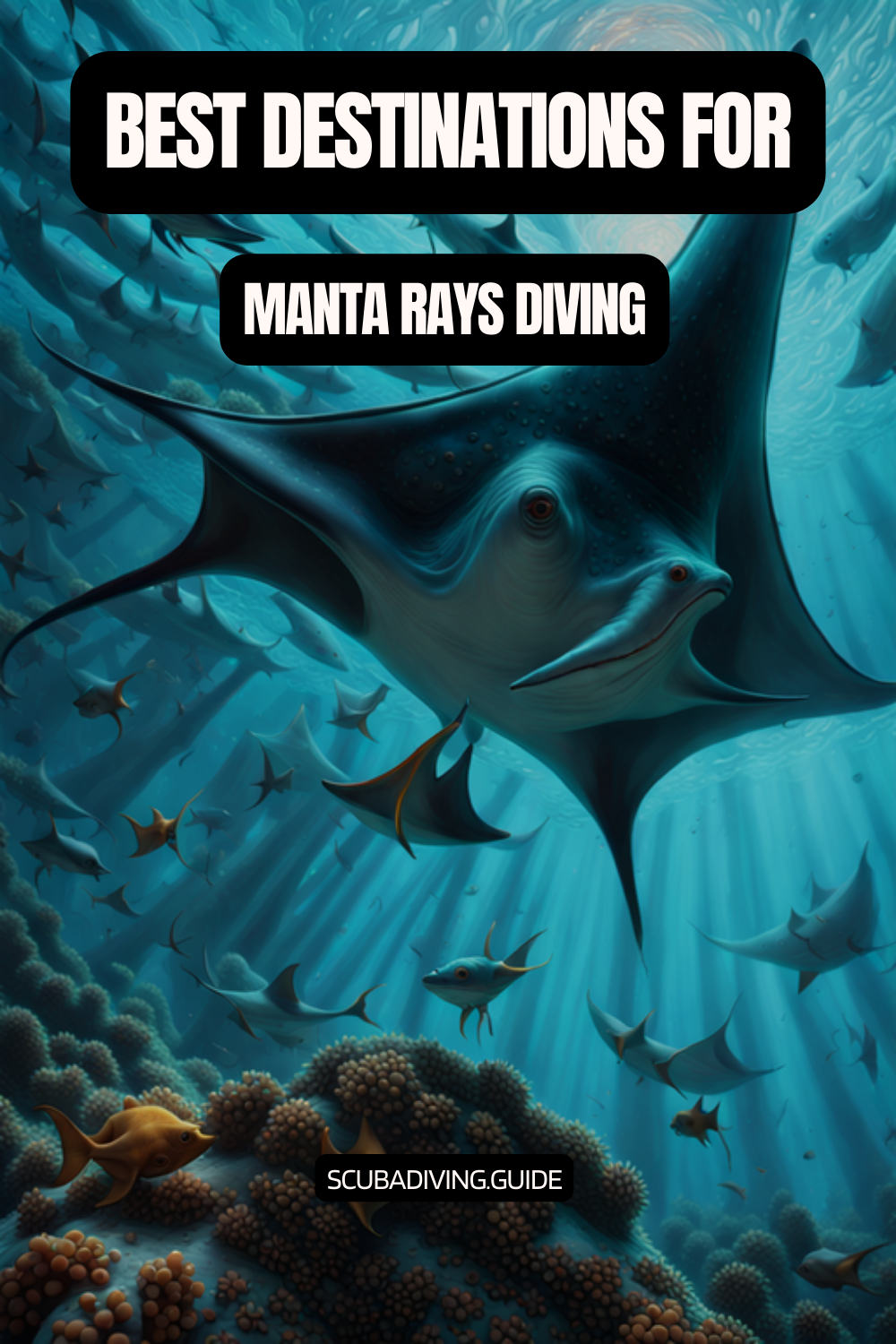
Pro tip for manta watching tours: Always follow local conservation guidelines and respect marine life during your underwater adventure.
Ideal Conditions for Manta Ray Experiences
To have a great time with manta rays, you need to know what they like. Snorkeling with these amazing creatures depends on many things. These things can really change your chances of seeing them in the wild.
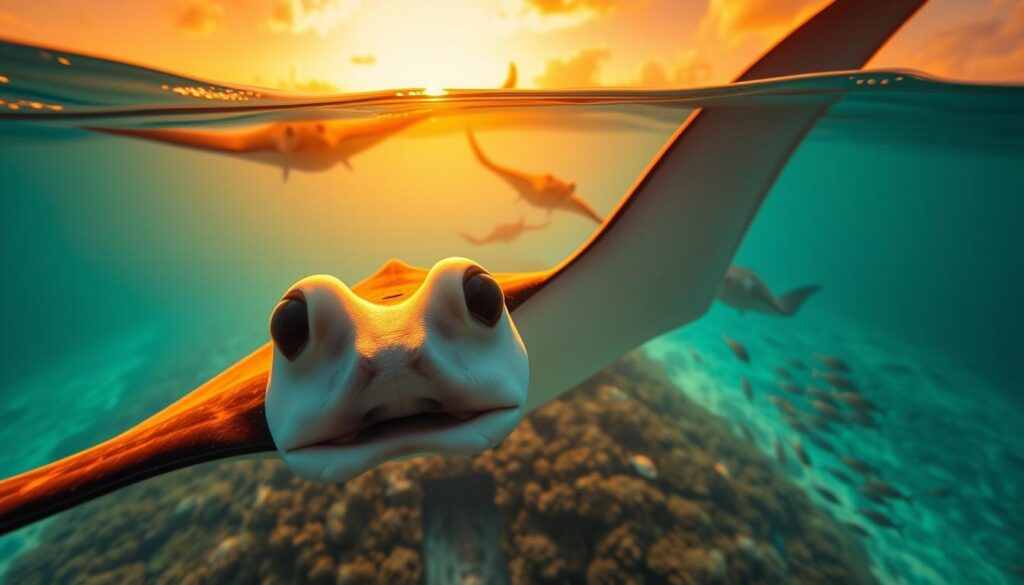
Seasonal Trends in Manta Ray Sightings
Manta rays follow the food, mainly plankton. Around the world, different places are best for seeing them at different times:
- Raja Ampat, Indonesia: Peak season from October to April
- Hanifaru Bay, Maldives: Hundreds of mantas from late June to October
- Kona, Hawaii: Best night dive opportunities in late spring and summer
- Socorro Island: Prime diving season from November to mid-June
Water Temperature and Visibility Considerations
The water where you dive is very important. Reef mantas tend to be more sedentary, while giant mantas travel long distances for food.
| Location | Best Months | Estimated Manta Population |
|---|---|---|
| Lady Elliot Island, Australia | June to November | ~100 individual mantas |
| Baa Atoll, Maldives | Year-round | 1,600+ identified mantas |
| Tofo, Mozambique | Year-round | 900 reef mantas, 100 oceanic mantas |
If you want to see manta rays, do your homework. Knowing when and where they move can make your trip unforgettable.
Gear Essentials for Diving with Manta Rays
Getting ready for scuba diving with Manta Rays needs careful planning and the right gear. Knowing the essential equipment makes your dive safe and memorable in many Manta Ray spots.
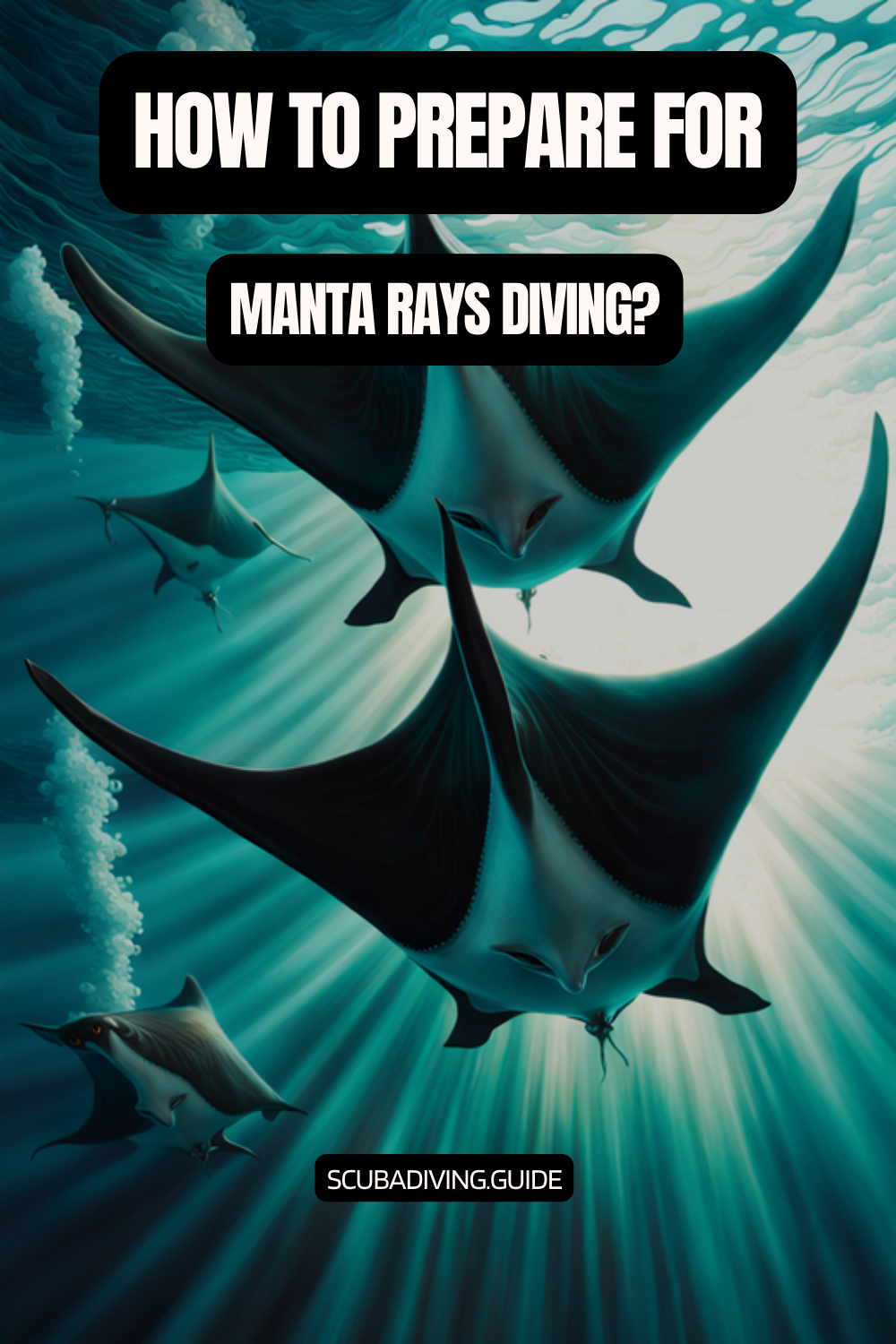
For a successful dive with manta rays, you need the right equipment. Divers should get high-quality gear for comfort and safety during these amazing marine meetings.
Recommended Diving Equipment
When getting ready for scuba diving with Manta Rays, remember to pack these key items:
- Mask: A good, fitting dive mask with anti-fog coating
- Fins: Comfortable, adjustable fins for easy movement underwater
- Wetsuit (3mm thickness recommended for tropical waters)
- Dive computer for tracking depth and time
- Underwater lighting for night dives
Safety Considerations While Diving
Keeping safe is key when diving with Manta Rays. About 50% of divers face equipment issues, so being prepared is vital.
- Carry a save-a-dive kit with 10-15 essential repair items
- Check equipment before each dive
- Ensure proper buoyancy control
- Follow local dive regulations
- Maintain neutral positioning near manta rays
Pro tip: Think about taking the PADI Equipment Specialist course to learn how to maintain your gear. Only 40% of divers regularly service their equipment, but it can greatly improve dive safety and performance.
Preparation turns a good dive into an extraordinary underwater experience.
Manta Ray Behavior and Interaction
Diving with manta rays gives us a rare look into their world. Their behavior is complex and fascinating. It captivates both marine enthusiasts and researchers.
Manta rays are amazing creatures with unique ways of eating and swimming. They show great intelligence and curiosity when they interact with divers.
Extraordinary Feeding Techniques
Manta rays have a special way of eating called cyclone feeding. This involves:
- Swimming in circular patterns
- Filtering zooplankton from ocean currents
- Using specialized gill rakers to trap microscopic food
Swimming Patterns and Movement
Manta rays move through the water with grace. Their swimming is almost like a dance. They show:
- Smooth barrel rolls
- Gliding with minimal energy
- Precise underwater navigation
When they interact with divers, manta rays show great curiosity. They often come close and swim through bubble streams. Their movements make encounters with them unforgettable.
| Behavior Category | Characteristics | Frequency of Observation |
|---|---|---|
| Feeding | Cyclone feeding technique | 85% of interactions |
| Social | Interaction with divers | 60% of encounters |
| Movement | Barrel rolls and gliding | 95% of observations |
Understanding manta ray behavior helps divers create respectful and memorable marine interactions.
Safety Tips for Diving with Manta Rays
Scuba diving with Manta Rays needs careful planning and respect for the sea. Knowing safety rules helps keep divers and these amazing creatures safe during their underwater meetings.
Understanding Marine Life Safety
When you dive with Manta Rays, safety comes first. These huge sea creatures can have wings up to 7 meters wide. So, being aware and careful is key.
- Maintain a safe distance of 3-4 meters from manta rays
- Never attempt to touch or chase the animals
- Follow your dive guide’s instructions precisely
- Stay calm and move slowly to avoid startling marine life
Dive Group Etiquette
Good behavior in the dive group is vital for Manta Ray protection and a great dive for everyone.
- Listen carefully to pre-dive safety briefings
- Ensure you have adequate swimming skills
- Avoid alcohol consumption before diving
- Use recommended diving equipment
Remember: Responsible diving practices protect both humans and marine ecosystems.
Manta rays are not aggressive and don’t have stingers, which makes them incredibly safe to observe. By sticking to these rules, divers can have amazing underwater experiences. They also help in Manta Ray conservation efforts.
Photography Tips While Diving
Capturing the magical world of manta rays through underwater photography requires skill, patience, and the right techniques. Scuba diving with Manta Rays presents a unique opportunity to document these incredible marine creatures in their natural habitat.
Successful manta ray photography depends on several critical factors. These can turn an ordinary shot into an extraordinary memory.
Best Practices for Underwater Photography
- Use wide-angle lenses to capture the massive wingspan of manta rays
- Select cameras with excellent low-light performance
- Practice buoyancy control to minimize marine life disturbance
- Choose cameras with fast autofocus capabilities
Lighting and Composition Techniques
Manta ray photography requires strategic lighting and thoughtful composition. Understanding how light behaves underwater can dramatically improve your images.
| Technique | Description |
|---|---|
| Strobe Positioning | Place strobes at 45-degree angles to reduce backscatter |
| Natural Light Usage | Shoot during golden hours for soft, ambient illumination |
| Composition | Include divers for scale and context |
Professional photographers recommend taking multiple shots. This increases chances of capturing the perfect moment. During one typical dive, photographers might capture around 350 images, with only a few truly remarkable photographs.
Remember: Respect for marine life always comes before getting the perfect shot.
Manta Ray Conservation Efforts
Marine conservationists worldwide are working hard to protect manta rays. These amazing creatures face many dangers that threaten their survival. Their numbers are dropping fast, so we must act quickly to save them.
In recent years, there have been big steps forward in manta ray conservation. In 2018, the National Marine Fisheries Service listed the giant manta ray as threatened. This shows how urgent it is to protect them.
Key Organizations Protecting Manta Rays
Many organizations are leading the fight to save manta rays:
- Manta Trust: Founded in 2011 to coordinate global research and conservation efforts
- NOAA: Developing conservation guidance to address manta ray bycatch
- IDtheManta Project: Creating advanced photo-identification technologies
How Divers Can Contribute to Conservation
Manta watching tours are a great way for divers to help conservation. Responsible tourism can really help:
- Participate in citizen science programs
- Support marine protected areas
- Respect marine life guidelines during dives
- Share awareness about manta ray conservation
The value of manta rays is huge, with tourists spending US$140 million a year to see them. By choosing eco-friendly manta watching tours, divers can help save them.
Conservation is not just about protecting a species, but maintaining the delicate balance of our marine ecosystems.
Manta rays have a low birth rate and face many dangers. Every person can help ensure their survival for the future.
Personal Experiences and Testimonials
Diving with manta rays is more than just a dive. It’s a chance to make unforgettable memories. These gentle giants connect with divers and snorkelers in a special way.
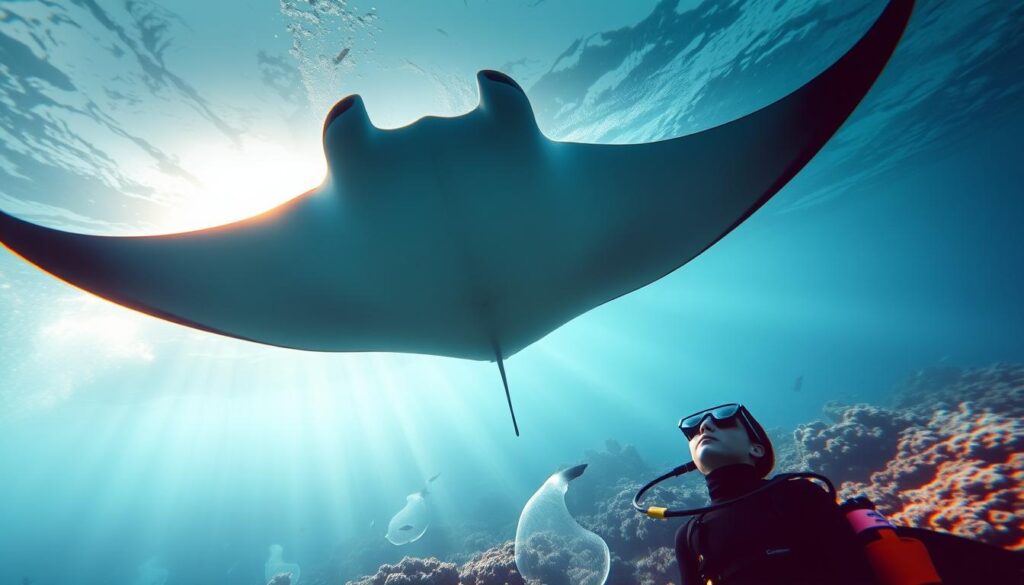
People who dive with manta rays say it’s magical. Swimming with these amazing creatures changes them. It leaves them feeling amazed and transformed.
Favorite Dive Memories from Enthuasiasts
Stories from divers show how manta rays impact us. Here are some highlights:
- Over 90% of divers say their manta ray swim is unforgettable.
- Dives usually last 30 to 45 minutes.
- Many feel happy and amazed by the experience.
Inspiring Stories of Manta Ray Encounters
“Swimming with manta rays completely changed my view of marine life. Their grace and curiosity were stunning.”
Snorkeling with mantas is an adventure like no other. The LA Times calls it one of the top ten dive experiences worldwide.
| Dive Statistic | Data Point |
|---|---|
| Maximum Manta Ray Wingspan | 15-18 feet |
| Underwater Visibility | 80-100 feet |
| Chance of No Manta Ray Sightings | 17% |
Manta ray encounters are more than just a dive. They are a journey that changes us. They challenge our views and leave us with lasting memories of the sea.
Common Marine Species Found Alongside Manta Rays
Diving with manta rays often offers the opportunity to encounter a diverse array of marine species that inhabit the same ecosystems. These encounters provide a glimpse into the intricate web of life that exists beneath the ocean’s surface. From tiny invertebrates to large pelagic fish, the presence of these species adds to the richness and biodiversity of the manta ray dive experience.
One common companion of manta rays is the cleaner fish. These small fish, often belonging to the wrasse family, play a vital role in maintaining the health and hygiene of manta rays. At cleaning stations, cleaner fish gather to remove parasites and dead skin from the bodies of manta rays. This symbiotic relationship benefits both parties—the manta rays receive a thorough cleaning, and the cleaner fish have a steady source of food.
In addition to cleaner fish, manta rays are often accompanied by various species of reef fish. Surgeonfish, angelfish, butterflyfish, and triggerfish are commonly seen darting in and around coral formations, providing a vibrant backdrop to the manta ray dives. These colorful and diverse fish species contribute to the overall beauty and visual spectacle of the underwater environment.
Pelagic fish such as tuna, barracuda, and jacks are often found patrolling the open waters where manta rays feed. These fast-swimming predators form schools and use their speed and agility to hunt for prey. Observing these sleek and powerful fish alongside the graceful movements of the manta rays creates a captivating contrast and highlights the dynamic nature of the marine ecosystem.
Whale sharks, the largest fish in the ocean, are occasionally encountered alongside manta rays. These gentle giants, with their massive size and distinctive markings, share similar feeding habits with manta rays, often congregating in areas of high plankton abundance. The sight of a whale shark swimming alongside manta rays is a truly awe-inspiring experience, as it showcases the diversity and grandeur of marine life.
Other marine species that may be spotted during manta ray dives include sea turtles, octopuses, eels, and various species of rays. Sea turtles gracefully glide through the water, occasionally coming up for air and offering a serene presence alongside the manta rays. Octopuses showcase their remarkable camouflage abilities, blending seamlessly into their surroundings. Eels, with their sinuous bodies, can be seen peering out from crevices and coral reefs. Rays, apart from manta rays, may include species like eagle rays or stingrays, each with its unique beauty and characteristics.
The presence of these diverse marine species highlights the interconnectedness and interdependence of the underwater ecosystem. Each species plays a vital role in maintaining the balance and health of the marine environment. Encountering these species alongside manta rays provides divers with a deeper appreciation for the complexity and wonder of marine life.
It is important for divers to approach encounters with these marine species with respect and caution. Maintaining a safe distance, avoiding any disruptive behavior, and adhering to responsible diving practices are crucial to protect the marine life and their habitats. By appreciating the beauty and diversity of the marine species found alongside manta rays, divers can foster a deeper connection to the natural world and contribute to their conservation.
Diving with manta rays offers an extraordinary opportunity to witness not only the majesty of these gentle giants but also the fascinating array of marine species that coexist in their habitats. These encounters provide a glimpse into the intricacies of the underwater ecosystem, reminding divers of the importance of conservation and the need to preserve these remarkable creatures and their underwater homes.
Conclusion: The Beauty of Diving with Manta Rays
Scuba diving with manta rays is an amazing underwater adventure. These huge creatures, with wings up to 7 meters wide, show us the beauty of the ocean. Places like Raja Ampat and Bali offer unique experiences for those who love the sea.
Manta rays are very important in the ocean. Sadly, their numbers have dropped by 70% in 30 years. Every dive is a chance to help protect these amazing animals and their homes.
Dive Highlights to Remember
Diving with manta rays is truly magical. You’ll see their beauty and smarts, whether it’s at night in Hawaii or in the Maldives. Remember, diving responsibly helps keep these creatures safe for others to see and protect.
Your Next Adventure Awaits
There are many places around the world where you can see manta rays. From Indonesia to the Caribbean, each spot is special. Get ready, dive right, and have an experience that will change how you see the sea.
FAQ – Scuba Diving with Manta Rays
What are the two species of manta rays I might encounter while diving?
You’ll likely see two types of manta rays: the giant manta ray and the reef manta ray. The giant manta ray is bigger and lives in deeper waters. The reef manta ray is found near coral reefs and in coastal areas.
Are manta rays dangerous to divers?
No, they’re not! Manta rays are smart and friendly. They don’t have stingers and won’t hurt humans. They might even come close to divers.
What is the best time of year to dive with manta rays?
The best time depends on where you are. In Kona, Hawaii, diving is great all year. In the Maldives, the best time is May to November. Always check the local conditions before you go.
How close can I get to manta rays while diving?
Dive guides say to stay at least 10 feet away. Move slowly and calmly. Let the mantas come to you. Never touch or chase them.
What equipment do I need for a manta ray dive?
You’ll need a wetsuit, dive mask, fins, and a dive light for night dives. If you’re taking photos, bring a camera with a wide lens. Always dive with a trusted operator who provides safety gear.
How can I contribute to manta ray conservation?
Choose responsible dive operators and join citizen science projects. Avoid places with bad marine practices. Support groups like Manta Trust and Marine Megafauna Foundation. Spread the word about protecting manta rays.
What makes manta ray night dives so special?
Night dives are special because lights attract plankton. This draws in manta rays. They do amazing tricks above divers, creating a stunning underwater show.
Are manta rays endangered?
Yes, they’re vulnerable. They face threats like overfishing and habitat loss. Their slow growth makes it hard for their numbers to recover.
Can I dive with manta rays if I’m not a certified scuba diver?
Yes! Many places offer snorkeling with manta rays. Kona, Hawaii, and the Maldives are great for seeing them from the surface.
What should I do if a manta ray approaches me during a dive?
Stay calm and don’t move suddenly. Avoid touching the manta ray. Enjoy the encounter while keeping a safe distance. They might swim close or do tricks.
